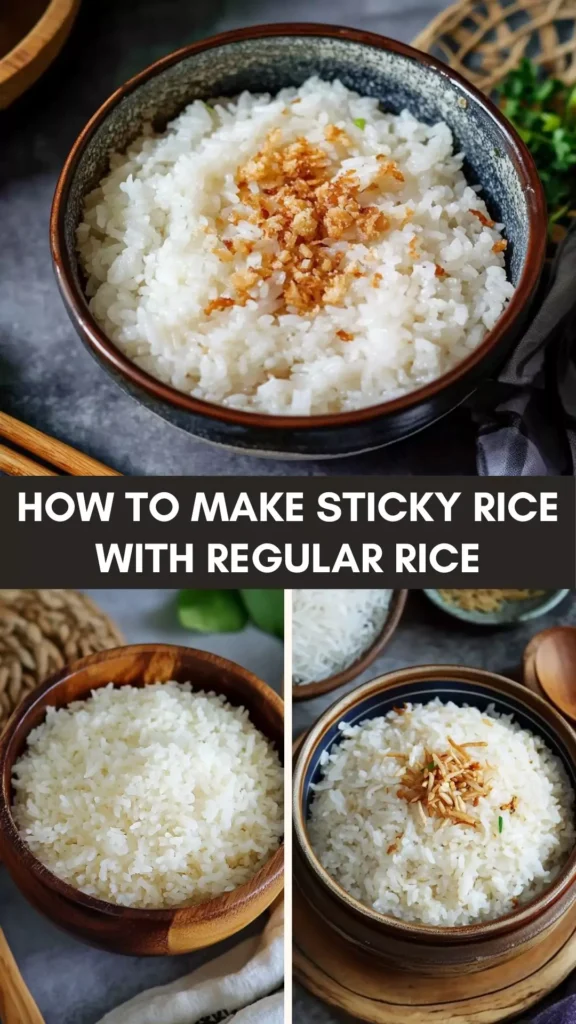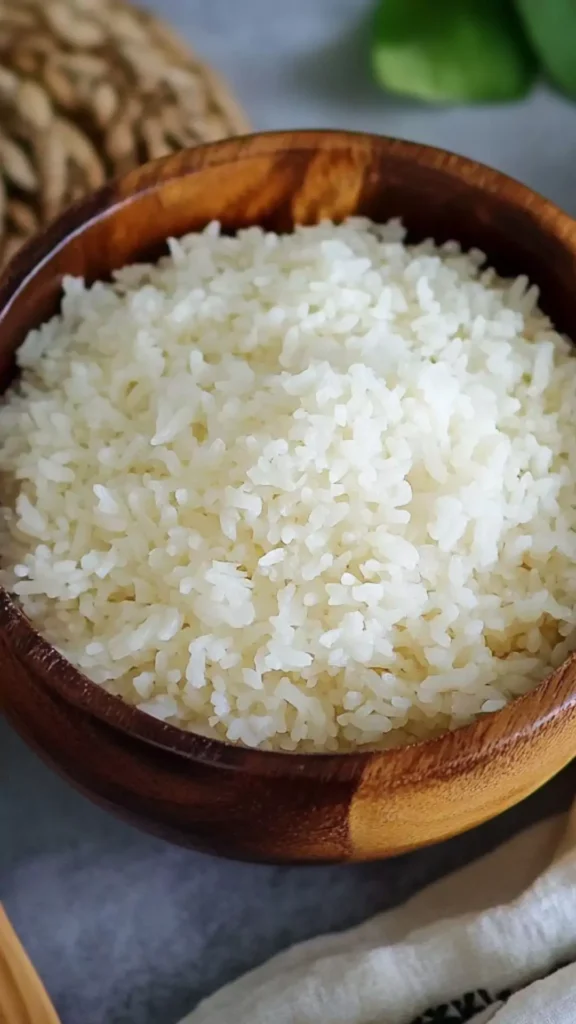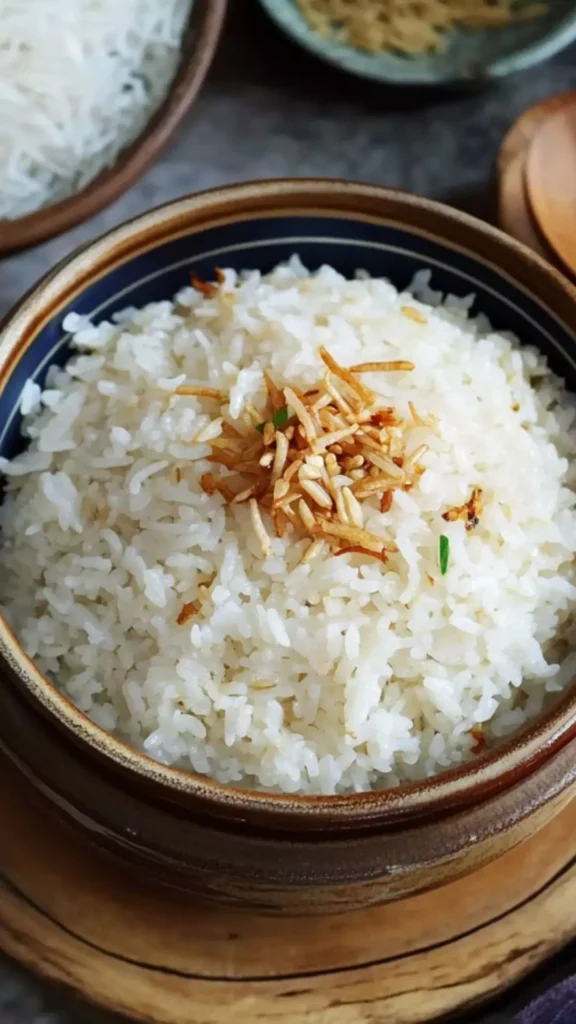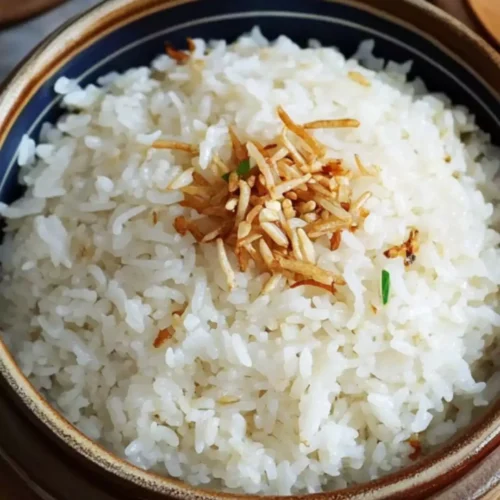How To Make Sticky Rice With Regular Rice – Viral Tiktok Recipe
Sticky rice is a true culinary chameleon. It goes well with a wide variety of dishes, from savory to sweet. Picture this: a delicious Thai green curry, where the creamy coconut base and spicy flavors meld perfectly with the stickiness of the glutinous rice.
Alternatively, consider serving it alongside grilled meats or roasted vegetables. You’ll also find it pairs wonderfully with some luscious mango slices for a yummy dessert. In fact, if you’ve never tried sticky rice with mango, are you even living?

So, here I was at an Asian market, browsing through baskets of produce and piles of rice. I stumbled across bags labeled “sticky rice,” and nostalgia rushed over me.
I remembered the delightful meals I had shared with friends and family, where sticky rice accompanied savory dishes and sweet treats alike.
But there it hit me: not everyone has access to this specialty rice. However, I found a way to make sticky rice using regular rice—a method that’s simple and effective.
You might be wondering, “What’s so special about sticky rice anyway?” It’s all about the texture and how it works beautifully in both savory and sweet dishes.
In this guide, I’ll walk you through making sticky rice with plain old regular rice. By the end of this journey, your kitchen will be filled with an alluring fragrance, and you’ll have a beautiful dish in front of you. Trust me; your friends and family will be right there, begging for seconds!
You will also like the following Side Dish recipes!
- Best Qdoba Mexican Grill Chips And Salsa Recipe
- How to make Qdoba Corn Salsa
- Easy Qdoba Pickled Onion Recipe
What is Sticky Rice with Regular Rice?
Sticky rice, also known as glutinous rice, has unique properties that make it chewy and clump together, which is perfect for eating with chopsticks or shaping into balls. But when you reach into your pantry and find nothing but regular rice staring back at you, don’t worry!
You can recreate that sticky texture quite easily with a few tweaks. The key is to increase the starch content in your regular rice, which can be achieved through soaking and cooking methods.
Flavor Profile of This Dish
The flavor profile of long-grain rice is generally neutral, which allows it to serve as a perfect canvas. A delicate hint of sweetness often emerges, especially when paired with mango or salted desserts.
With savory accompaniments, the flavor shifts to something more earthy and hearty. In other words, this sweet rice isn’t competing with your main dish but instead supports it.
Why You’ll Love This
What’s not to love? It’s easy to make, uses ingredients that most of us already have, and can elevate many meals.
Plus, it serves as a fun activity for family members. Kids can form rice balls or help shape it into a creative dish. The best part? By mastering this technique, you add versatility to your culinary repertoire.
Ingredients
– 2 cups water
– 1 to 1 ½ cups regular rice
– A few extra tablespoons of water
– 1 teaspoon salt
– 1 tablespoon rice vinegar

Step-by-Step Instructions
Step 1: Rinse the Rice
Start by rinsing 1 to 1½ cups of your regular rice under cold water. This not only washes away excess starch but also enhances the texture later on.
Allow it to soak in clean water for about 30 minutes. Soaking is essential. It allows the grains to absorb the water and soften, making your rice dreams come true.
Step 2: Drain
Afterward, drain the rice in a fine-mesh colander. You want every drop of that soaked water gone. This step helps in achieving a clumping effect when you cook it.
Step 3: Boil Water
In a medium pot, bring 2 cups of water to a gentle boil. Once it starts bubbling, toss in the drained rice along with the salt. Stir it only a couple of times—over-stirring can make your rice gummy.
Step 4: Steam the Rice
Here comes the trick. After adding the rice, lower the heat to a simmer and cover the pot. Let the mixture cook for about 15-20 minutes.
If the water evaporates too quickly, don’t hesitate to add a few more tablespoons of water. You’re looking for that soft yet firm texture.
Step 5: Rest
Once the time is up, remove the pot from heat. Cover it for an additional 10 minutes. This resting time allows the rice grains to finish cooking in its steam.
Step 6: Add Rice Vinegar
After resting, fluff the rice gently with a fork and mix in 1 tablespoon of rice vinegar. This is where the magic happens—the vinegar enhances the flavor subtly and adds to the stickiness.
Step 7: Serve
Your dish is ready! Enjoy this perfect rice with your favorite item or as a dessert. You can form it into balls or serve it in bowls.
Tips & Tricks
- Use Short Grain Rice: While jasmine is great, using short-grain rice tends to create more sticky results.
- Don’t Rush the Soaking: The longer you soak, the better the texture. Aim for at least 30 minutes, but if you can soak overnight, do it!
- Save Leftovers: If you have this extra sushi rice, refrigerate it. Just reheat it with a splash of water to restore its stickiness.
- Experiment with Flavors: Add coconut milk while cooking if you want a sweeter flavor profile.
- Check Consistency: Depending on the type of rice you use, you might need to adjust water levels.

How Can You Store This Rice?
Storing sticky rice is straightforward. Place it in an airtight container and keep it in the refrigerator for up to a week.
To reheat, add a small splash of water, cover it, and microwave for about 30 seconds. This will help regain some moisture.
Alternatives for Missing Ingredients
You might find yourself short on a few ingredients. No worries! Here are some alternatives:
- Rice Vinegar: If you don’t have rice vinegar, apple cider vinegar or white vinegar can be good substitutes. They will offer a different flavor but will still provide acidity.
- Salt: If you’re watching your sodium intake, you might consider using low-sodium soy sauce to add flavor without too much salt. Just a teaspoon can do wonders.
- Regular Rice: In a pinch, you can use brown rice, though you’ll need to adjust cooking times and water amounts, as it requires more hydration.

Easy Sticky Rice With Regular Rice
Equipment
- Medium pot
Ingredients
- – 2 cups water
- – 1 to 1 ½ cups regular rice
- – A few extra tablespoons of water
- – 1 teaspoon salt
- – 1 tablespoon rice vinegar
Instructions
Step 1: Rinse the Rice
- Start by rinsing 1 to 1½ cups of your regular rice under cold water. This not only washes away excess starch but also enhances the texture later on.
- Allow it to soak in clean water for about 30 minutes. Soaking is essential. It allows the grains to absorb the water and soften, making your sticky rice dreams come true.
Step 2: Drain
- Afterward, drain the rice in a fine-mesh colander. You want every drop of that soaked water gone. This step helps in achieving a clumping effect when you cook it.
Step 3: Boil Water
- In a medium pot, bring 2 cups of water to a gentle boil. Once it starts bubbling, toss in the drained rice along with the salt. Stir it only a couple of times—over-stirring can make your rice gummy.
Step 4: Steam the Rice
- Here comes the trick. After adding the rice, lower the heat to a simmer and cover the pot. Let the mixture cook for about 15-20 minutes.
- If the water evaporates too quickly, don’t hesitate to add a few more tablespoons of water. You’re looking for that soft yet firm texture.
Step 5: Rest
- Once the time is up, remove the pot from heat. Cover it for an additional 10 minutes. This resting time allows the rice to finish cooking in its steam.
Step 6: Add Rice Vinegar
- After resting, fluff the rice gently with a fork and mix in 1 tablespoon of rice vinegar. This is where the magic happens—the vinegar enhances the flavor subtly and adds to the stickiness.
Step 7: Serve
- Your sticky rice is ready! Enjoy it with your favorite dish or as a dessert. You can form it into balls or serve it in bowls.
Notes
- Use Short Grain Rice: While jasmine is great, using short-grain rice tends to create more sticky results.
- Don’t Rush the Soaking: The longer you soak, the better the texture. Aim for at least 30 minutes, but if you can soak overnight, do it!
- Save Leftovers: If you have extra rice, refrigerate it. Just reheat it with a splash of water to restore its stickiness.
- Experiment with Flavors: Add coconut milk while cooking if you want a sweeter flavor profile.
- Check Consistency: Depending on the type of rice you use, you might need to adjust water levels.
Nutrition
Frequently Asked Questions
1. Can I use brown rice to make sticky rice?
Yes, but brown rice requires longer cooking times and more water. You should typically double the cooking time and water ratio. It won’t be as sticky as white rice, but it’s a healthy option.
2. How can I enhance the stickiness of the rice?
You can try soaking the rice longer, or add a bit of cornstarch to the water before cooking. However, this method can alter the taste a bit.
3. What dishes pair well with sticky rice?
You can enjoy it with curries, grilled meats, or even some spicy dishes. It also complements sweets like mango or coconut milk desserts beautifully.
4. Can I use a rice cooker to make sticky rice?
Absolutely! Just follow the same steps of rinsing and soaking the rice, then use the rice cooker’s white rice setting.
5. What should I do if my rice turns out too dry?
If you find yourself with dry rice, add a little boiling water and let it steam in the covered pot for an additional few minutes. Just be cautious not to add too much at once.
Conclusion
Making sticky rice with regular rice isn’t just possible; it’s rather simple and accessible. Armed with this knowledge, you can now elevate your culinary creations. Whether you’re pairing it with savory dishes or sweet delights, this recipe serves you well.
Take the plunge and give it a try. I promise, once you master this technique, your kitchen will never be the same again. So, go ahead and amaze your family with this delightful sticky rice!
